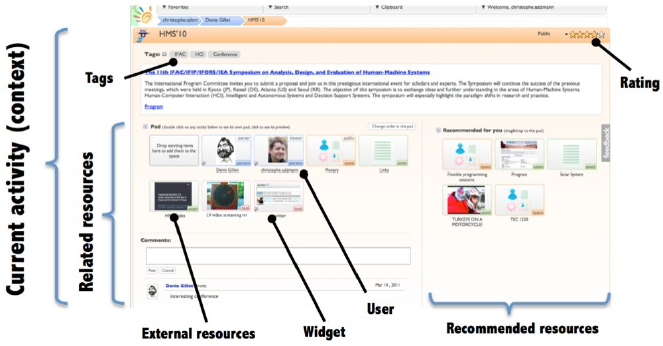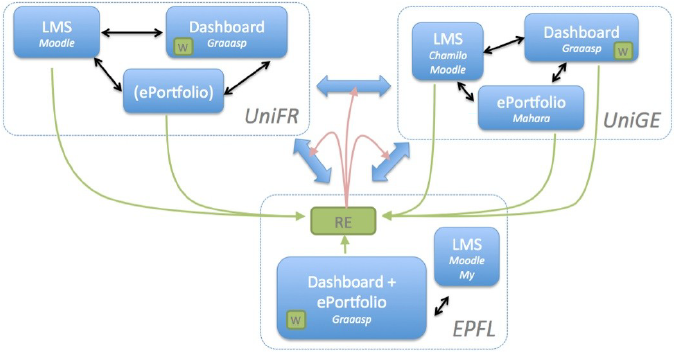Technological objective
A dashboard as a solution for integrating different applications and content
Based on the PLE pre-study (unige.6), we inferred an interest in the development of a dashboard, which can be compared to a single entry point for all available tools and services. Such a dashboard seems to respond to student's practices, as it enables them to quickly check available resources, which are either pre-integrated (but may be disabled by the user) or integrated by the students themselves. By their collaborative nature, resources will not be limited to those provided by a single institution, but will be shared between institutions or gathered directly from the Web. Another objective of this development is the creation of user profiles (templates) dedicated to the Dashboard. These models will be pre-filled from a predefined set of resources, and will then be associated with user profiles - bachelor, master, doctoral student, teacher, etc. Each user can thus be offered a default environment, with the possibility to customize it by removing or adding resources.
Tool selection - Graaasp
During the preparing phase of the project (unige.8), we tested and compared several solutions to implement a PLE. This led us to select Graaasp as a potential tool to implement a dashboard.
Figure 3 shows the Graaasp user interface which acts as a dashboard to display both related and recommended resources according to a given context or activity. Related resources are defined by the activityfs owner and can be of types: activities, users, assets or tools (using widgets). External resources can also be linked to the current activity. The recommendation engine (RE) suggests resources of interest to the current activity based on its internal calculation which considers: resources relationships, user actions, ratings and tags. Additional views can be designed via the help of skin widgets. Graaasp is described in more details in section 4.

Figure 3. Graaasp main user interface
Resources sharing and federation
The institutional information will be federated and recommended with the help of the contextual recommendation engine (RE) developed at EPFL (Fig. 3). The RE gathers available institutional information (green lines). After computation, a recommendation is provided to the users via the dashboard widgets (green eWf boxes) or through other means. Then, the recommended information will be made exchanged between institutions (blue arrows). The whole process and infrastructure will thus work as a cross-institution federating hub.

Figure 4. Federating hub: the recommendation engine (RE) gathers information from different institutions and recommends it to other parties via a dashboard.
Integration of the ePortfolio
The objective is to integrate Mahara with didactic activities fed by teachers and students. Based on the results obtained from the ePortfolio pre-study, we know that these activities mainly consist to:
- Provide an easy management of student productions (i.e., collect, select, reflect, present).
- Allow a better monitoring of the student activities by the teachers.
- Integrate reference lists of competences and learning outcomes to help students manage their progression in learning.
- Ensure the interoperability and the sustainability of the contents.
Some of the aspects cited above are already included in the Mahara platform (e.g., most of the student production management). For the aspects that are not currently available, our goal is to integrate them in Mahara.

